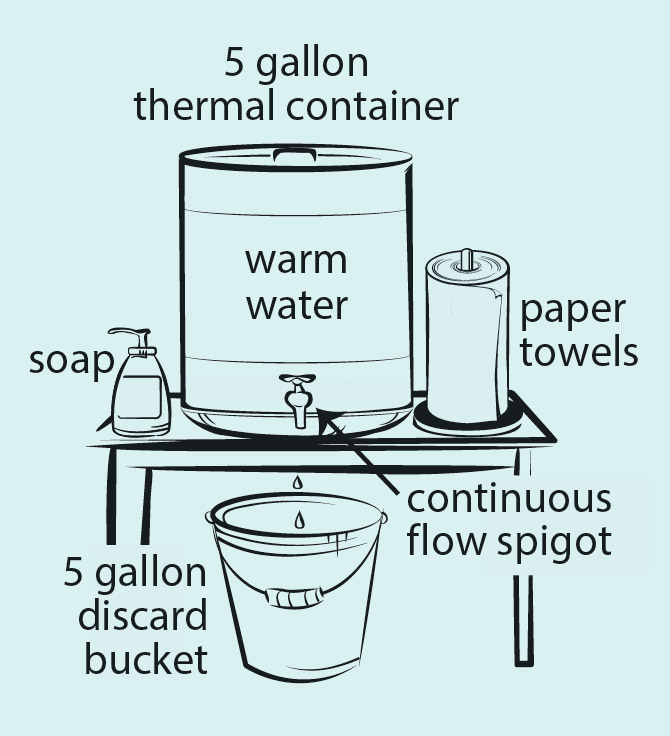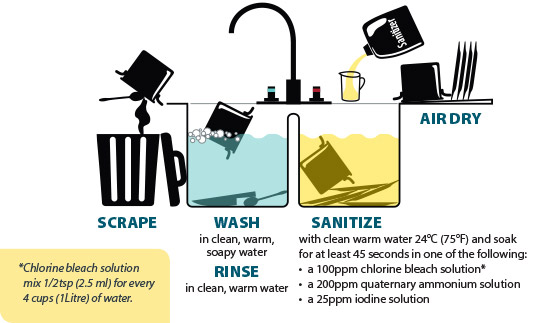To prevent your customers from getting sick from a food-borne illness, follow the guidelines listed below to meet the food safety requirements to operate your business.
Failure to meet the requirements may result in a delay or inability of your food booth to offer food for the public. If any health hazard is found to exist during the operation of your food booth, the Health Unit may require you to stop operation until the health hazard is removed.
Roofing and side walls
- Food preparation must be done in an enclosed area with a roof and at least two sides or walls. The front will be used for sale and service of food and the back will be used as an opening to the cooking area. Note: Gasoline/propane fueled equipment such as barbecues or grills must meet the Fire Department’s Fire Code.
Food Preparation Surfaces
- Food preparation surfaces must be smooth, in good repair, non-absorbent, and easily cleanable.
Potable Water Source
- Food booths must be supplied with a potable (clean) water source. All water lines should be disinfected prior to use and meet the plumbing code.
Dishwashing
- If required, the event organizer should provide on-site dishwashing and food vendors should have access to a two compartment sink with hot and cold running water for utensil washing within event grounds.
Handwashing Sink
- Designated handwashing sinks are required to have the following:
- Hot and cold running water (or lukewarm water supply).
- Liquid soap in a dispenser.
- Paper towels.
If a portable hand sink is not available, a temporary hand wash sink may be constructed following the diagram below:

Waste and garbage removal
- Rodent-proof garbage bins with lids must be provided for waste storage, emptied when needed, and be maintained in a clean and sanitary manner. Liquid waste should be appropriately disposed. See your organizer for more information.
Food Source
- All food must be obtained from an approved source and prepared in an inspected food premises.
- All packaged food should have proper labelling that identifies the company name, address, contact information, and ingredient list. For more labelling requirements contact the Canadian Food Inspection Agency.
- Records of all food must be kept for at least a year.
Cross-Contamination Prevention
- All food and food supplies must be stored, prepared, and transported in a manner that protects it from contamination.
- Raw and ready-to-eat products must be fully separated and stored in tightly covered containers to prevent cross-contamination. This includes during transportation to and from the event.
- In the refrigerator, raw foods (e.g., meat, seafood) must be stored on the lowest shelf.
- Use separate cutting boards when preparing raw meat and ready-to eat foods such as produce.
- Food on display must be covered with a sneeze guard, or containers with lids or covers.
- Food shall be handled with utensils such as tongs, scoops, or spoons as much as possible to avoid contact with hands.
- Additional clean utensils must be available on-site and stored in a sanitary manner.
Food Storage
- All foods must be stored in clean, food-grade containers and be covered.
- All food must be stored off the ground.
- Single-service utensils (e.g., plastic, paper or Styrofoam, toothpicks, or serving spoons) are preferred. If multi-service utensils are to be used, a three compartment sink must be provided on-site.
Use a calibrated probe thermometer to check internal temperatures of potentially hazardous foods.
| Temperature Control | Requirement | Minimum Internal Temperature |
|---|---|---|
| Cooking Temperatures | All hazardous foods must be cooked to the minimum internal cooking temperature for at least 15 seconds. | 82°C (180°F) Whole Poultry 74°C (165°F) Poultry (includes ground poultry) 74°C (165°F) Food mixtures containing poultry, eggs, meat, fish or other hazardous foods71°C (160°F) Pork, ground meat70°C (158°F) Fish and seafood |
| Reheating | Foods must reach minimum internal temperature for at least 15 seconds, and be reheated within 2 hours. | Reheat to the original minimum internal cooking temperature. See above for cooking temperatures. |
| Hot Holding | Cooked foods that are to be served hot must be maintained at the minimum internal temperature. | 60°C (140°F) or higher |
| Cold Holding | All hazardous foods must be stored at the minimum cold temperature.Refrigeration is strongly recommended. | 4°C (40°F) or colder |
| Cold Holding - Frozen | Frozen foods must be kept frozen. | -18°C (0°F) or colder |
| Thawing | Never thaw foods at room temperature. Thaw foods in the fridge or in a sink under cold, running water. | 4°C (40°F) or colder |
Potentially Hazardous Foods
All potentially hazardous foods must be kept at an internal temperature of 4°C (40°F) or colder, or 60°C (140°F) or higher.
A potentially hazardous food is a food capable of supporting the growth of harmful microorganisms or the toxins the microorganism produces. Examples include but are not limited to meat, poultry, eggs, milk products, fish, seafood, rice, and pastries with cream filling.
All food handlers must practice good personal hygiene.
- Wear clean outer garments.
- Wear headgear to prevent hair from contaminating food (e.g., hat, hairnet etc.).
- Do not smoke or eat while preparing foods.
- Do not prepare food while ill.
- Properly wash hands with soap and water:
- Before and after preparing foods (especially after handling raw meats).
- After using the toilet.
- After sneezing, coughing, or touching the face.
- After handling money.
- After handling garbage.
- Before wearing disposable gloves and after removing disposable gloves.
Cleaning and Sanitizing
Food contact surfaces must be properly cleaned and sanitized.
- Use an approved sanitizer (see list below).
- Test strips are required to verify sanitizer concentration.
- Provide a sanitizer bucket or spray bottle to sanitize food contact surfaces.
- Follow the manufacturer's instructions on preparation and use for sanitizers.
- Label all sanitizer buckets and spray bottles.
- Wiping clothes must be stored in a sanitizer solution or be single use only.
- Chemicals must be stored away from food.
Approved sanitizer includes the following:
- Chlorine (e.g., household bleach) at 100 ppm (parts per million).
- Quaternary Ammonium at 200 ppm.
- Iodine at 25 ppm.
- Other sanitizing agents (must be approved by Health Unit before use).
Manual Two Compartment Sink Dishwashing
If dishwashing facilities are available, equipment and utensils must be washed and sanitized in a two-compartment sink after each use following this method:

Certified Food Handler
- A food handler or supervisor certified in food handling must be on-site during all operating hours of the event.
- A copy of the certificate must be provided. (Check the expiry date).
Handwashing Station
- Handwashing station and supplies (e.g., hot and cold water or warm water, paper towels, and liquid soap in a dispenser).
- Waste water container (if using a temporary handwashing station).
Temperature Control
- Accurate indicating thermometers in all cold storage units.
- Calibrated probe thermometer to verify internal food temperatures.
- Coolers and refrigerators are maintained at 4°C (40°F) or colder.
- Plenty of ice or ice packs for all coolers.
- Frozen foods remain frozen.
- Foods in hot holding units are maintained at 60°C (140°F) or higher.
Equipment and Utensils
- Single service utensils.
- Extra utensils (e.g., tongs, spoons, knives etc).
- Electric hot holding units or chafing dishes to keep foods hot.
Food Storage
- Platform or shelving to elevate food and other items off the ground.
- Covers or lids for food storage.
- Food-grade containers provided.
Personal Hygiene
- Headgear (e.g., hats or hairnets).
- Clean outer garments.
- Disposable gloves available for food handlers with cuts, open sores, or bandages on their hands.
Cleaning and Dishwashing
- Dishwashing detergent.
- Approved sanitizer solution in buckets or spray bottles.
- Sanitizer test strips.
- Dishwashing area with two designated sinks (if required).
- Wiping cloths.
Waste and Garbage Control
- Rodent-proof garbage containers with lids.
- Garbage bags.

